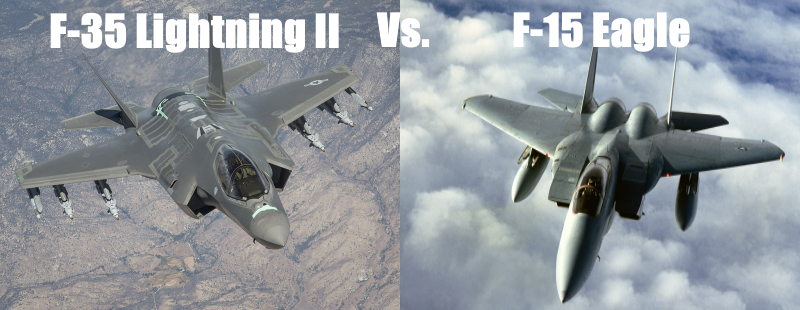F-15 vs. F-35 – It’s a tightly contested showdown.
In one corner, the F-15 fighter presents a tremendous legacy along with a new fifth-generation version in the F-15EX.
Then, you have the F-35 Lightning II, which is arguably the best stealth fighter in the world.
For this reason, the F-15 vs. F-35 debate generates plenty of attention.
Continue reading to discover 8 Big Differences between the F-15 and F-35 fighter.
Related Article – 10 Best Fighter Jets In The World
F-15 vs. F-35: The Debate
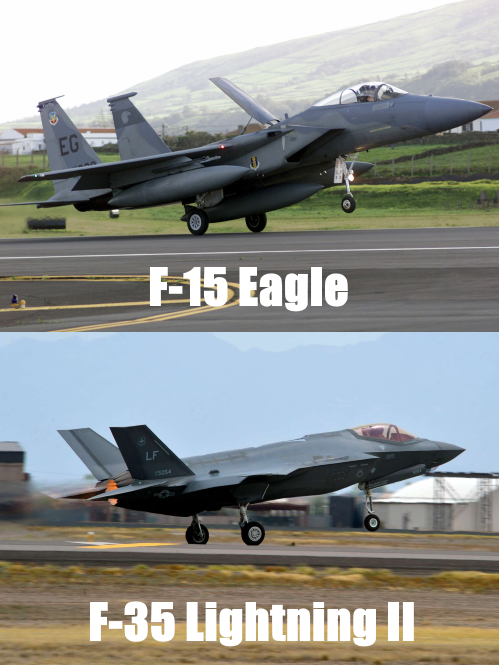
The incredible history of U.S. military aviation includes some of the finest aircraft the world has ever seen.
These include lethal strikers and stealth fighters like the F-15 and F-35.
The McDonnell Douglas F-15 Eagle features a noteworthy legacy, which includes the recent arrival of its fifth generation variant – the F-15EX Strike Eagle.
Of course, there is also the Lockheed Martin F-35 Lightning II which is an impressive, versatile fighter in its own regard.
Therefore, those in aviation often like to debate which aircraft is better: F-15 vs. F-35.
It’s a highly contested discussion especially when you consider the pros and cons of each modern fighter.
Recently, the United States Air Force (USAF) made headlines regarding the F-15EX.
The new, fifth-generation fighter expects to slowly phase out other popular USAF fighters like the F-22 Raptor.
Moreover, with the U.S. government considering selling F-35s to the United Arab Emirates (UAE) and Qatar destined to acquire Boeing F-15 Eagles, the landscape in the air is soon to change.
Nonetheless, not everyone is excited about the Air Force’s decision to move away from stealth fighters like the F-35.
Despite it, there is little argument that the F-35 and F-15 remain 2 of the best American fighters of all time.
Thus, it’s also an interesting discussion to break down each modern fighter, examining 8 big differences in particular.
F-15 vs. F-35: 8 Big Differences
What distinguishes the F-15 from the F-35 fighter?
For starters, each fighter was designed in different eras and for different purposes.
Consequently, there are advantages and disadvantages to the F-15 and F-35.
In general, the F-15 Eagle performs better in terms of air superiority.
On the other hand, the F-35 Lightning II serves more as a battlefield “quarterback.”
In other words, the F-35 is stealthy enough to sneak behind enemy lines yet also lethal enough to pick off enemy fighters.
Notwithstanding, there are 8 essential differences in the F-15 vs. F-35 debate:
- History
- Design
- Performance
- Maneuverability
- Armaments
- Stealth
- Avionics
- Reputation
How does the F-15 compete with the F-35 in the air?
Let’s compare and contrast the F-15 and F-35 fighters in more detail.
Related Article – F-35 Vs. Su-57: 8 Big Differences Between The Lightning II & Felon
#1. History
The F-15 fighter traces its origins to the beginning of the Vietnam War.
During this era, the U.S. Air Force and Navy were competing for the next tactical aircraft of the future.
As a result, the U.S. government sought to develop a medium-range interdiction aircraft for the USAF; and a long-range interceptor for the U.S. Navy.
Ultimately, the Armed Forces were seeking a fighter that could provide air superiority through direct support.
The F-15 was a direct response to the Soviet MiG-25 aircraft.
At the time, there was legit concern that the MiG-25 outperformed the U.S. F-4 in many regards.
For this reason, the Department of Defense (DoD) focused on developing a high-speed, high-altitude interceptor.
In 1972, the F-15A officially took flight with the F-15B following a year later.
There are multiple versions of the F-15 fighter that have appeared since the early 1970s:
- F-15A & F-15B (1972 – 1979)
- F-15C & F-15D (1979 – 1985)
- F-15J & F-15DJ (1981 – 1997)
- F-15N Sea Eagle (1979 – Current)
- F-15E Strike Eagle (1985 – Current)
Moreover, the DoD currently has 2 new proposed variants: F-15SE Silent Eagle and F-15 2040C.
Then, there is the F-35 fighter which does not have nearly the same history.
The Lockheed Martin F-35 Lightning II is a 5th-generation fighter.
As such, the U.S. government first started planning on creating the F-35 fighter in the early 2000s.
The F-35 was designed to replace other fighters, including the F-15 and F-16.
As a result, the F-35 Lightning II debuted at approximately the same time as the F-22 Raptor.
The F-35 first took flight in 2006 and entered service less than a decade later (2015).
Today, the U.S. Air Force and Navy continue to use F-35 fighters, yet that will change in the next decade.
There are numerous variants of the Lockheed Martin F-35, including:
- F-35A (U.S. Air Force)
- F-35B (Marine Corps)
- F-35C (U.S. Navy)
- F-35l “Adir”
Several other allied nations also depend on F-35 stealth fighters including Canada, Australia, Israel, Norway, Italy, and The Netherlands.
Related Article – 17 Types Of Navy Aircraft / Fighter Jets
Recent Updates
The nearly $857.9 billion dollar budget of the U.S. military is unprecedented.
Nevertheless, it has contributed to some of the finest aircraft in the world.
Still, the quest to determine the next generation fighter of the U.S. military is a complex puzzle.
For example, one of the current debates is whether the Air Force should continue to devote funding to creating a newer version of the F-15 or shift focus entirely to the F-35.
Interestingly enough, the recent trend from other countries around the globe is investing in highly modernized versions of the F-15.
Therefore, some are in the corner of the F-15 fighter insisting that the DoD needs to create its own next-generation version.
Then, there is the other side of the discussion.
The F-35 Lightning has been the primary striker of the USAF since 2009.
And, despite being a popular aircraft for many pilots, is threatened by a new rival – the F-15EX.
The new fighter is a variant of the F-15 Strike Eagle yet with modern gadgets like advanced avionics and stealth capabilities (more details, below).
Consequently, the announcement of the new F-15EX has established some divide between the aircraft and the F-35.
The Air Force does plan to purchase more than 100 F-15EX aircraft in the next decade, meaning it will challenge the future of the F-35.
Nevertheless, not everyone in the military branch supports the transition from the F-35 to F-15EX.
Regardless, the decision to phase away from F-35Cs is partly related to the age and condition of the fighters.
It’s true, by now, the military branch planned on retiring the iconic fighter yet has been having difficulty finding a replacement.
Perhaps the F-15EX can fill that void since it requires little additional development and offers a ton of promise.
#2. Design

The initial versions of the F-15 Eagle featured a single-seat and twin-seat variant.
All in all, McDonnell Douglas (now Boeing) was seeking to develop a twin-engine, all-weather tactical fighter that could match pace with the MiG-25.
The F-15 fighter did precisely that including for the U.S. Air Force where it represented the primary air superiority fighter for decades.
Accordingly, there are several prominent features of the F-15 aircraft that make it unique (compare to the F-16 fighter).
Later, the U.S. government focused on producing various alternatives including the F-15E Strike Eagle.
The fighter entered service in 1989 and has been exported by numerous other nations.
Then, there is the most recent F-15EX fighter which poses a threat to the future of the F-35.
The F-15EX is considered an upgrade over the F-15E Strike Eagle thanks to enhanced radar, improved avionics, and a revised cockpit with a new display.
Be that as it may, the F-15EX also presents some design concerns.
For example, the modern fighter is based on a nearly 50-year-old airframe, which doesn’t inspire many to believe it’s a next-generation fighter.
The older airframe presents some modern technological challenges, including armament configuration.
Consequently, some argue that the new F-15 variant is not stealthy enough, especially compared to the F-35.
Russia and China have recently unveiled new missile and air defense systems that anticipate rivaling 4th generation fighters.
Therefore, some believe the F-15EX is vulnerable to the latest cutting-edge missile systems such as Russia’s S-500 Triumfator-M.
The system reportedly features the latest advancements in detection, tracking, and targeting.
As a result, some fear that modern fighters like the F-15EX are not stealthy enough to survive in contested airspace (in contrast to the F-35 Lightning II).
Related Article – F15 Vs. F22: Top 10 Differences Between The Eagle & Raptor
F-35 Lightning II
Indeed, the F-35 fighter is among the stealthiest aircraft in the world.
It has recently sparked a rival with the new Sokhoi Su-57 Felon (which is Russia’s first stealth fighter).
The F-35 aircraft features a radar cross-section (RCS) which is equivalent to the size of a metal golf ball.
Thus, it’s nearly undetectable and – furthermore – can disrupt hostile signals as well as wreak havoc in numerous regards.
The other impressive design features of the F-35 fighter include a world-class electronic countermeasures (ECM) suite and a unique wing-tail configuration.
Lockheed Martin produced a single-seat, single-engine stealth fighter that is designed to operate in all-weather environments.
Furthermore, the F-35 Lightning II performs both air superiority and strike missions.
It can also evolve for electronic warfare with the ability to interfere with other signals, including intelligence, surveillance, and reconnaissance capabilities.
The aircraft features 3 main variants which are utilized by the Air Force (F-35A), Navy (F-35C), and Marine Corps (F-35B), respectfully.
The F-35 is different from other advanced fighters in that it emphasizes avionics, stealth, and long-range combat.
It’s extremely lightweight and hard to catch for a single-engine design.
In the end, the F-35 aircraft draws a lot of inspiration from the F-22 Raptor, which it was designated to replace in the early 21st century.
#3. Performance
F-15 vs. F-35?
The 2 aircraft are extraordinary in different regards, including performance.
What complicates the discussion is the 2 fighters are built for different purposes.
For starters, the twin-engine F-15EX is substantially faster (Mach 2.5 compared to Mach 1.6) and covers a larger combat range (1,000 miles to 870 miles).
Accordingly, it’s far more powerful and outstanding at air superiority in areas that are lightly contested.
Meanwhile, the single-engine F-35 lacks the sheer acceleration and force of the F-15 fighter yet is much more discreet.
The stealthy F-35 aircraft is much more compact, and lightweight, and presents a much smaller radar profile.
Therefore, if you are seeking a multi-role fighter that provides close air support, air superiority, or all-weather strike it’s one of the best options.
While the F-35 lacks the raw performance of the larger, twin-engine F-15, it’s still a worthy adversary.
The F-35 performs better in contested airspace, especially when launching strikes and evading enemy forces.
Nevertheless, the F-15C only supports air-to-air combat and thus primarily defends U.S. installations as well as foreign military bases.
The F-15EX models much of its design after the F-35 (nearly 70% of the components are similar).
It makes sense considering that the F-15EX is slated to replace the previous duties of the F-35, such as patrolling U.S. airspace and defending military installations.
The terrific combat range (1,200 miles) requires less aerial refueling along with a more powerful twin-engine.
Still, one of the noticeable F-15 vs. F-35 differences is how the fighters perform in deep penetrating strikes.
Currently, the F-35 is much more adaptable at challenging sophisticated, long-range radars and SAMs like the systems Russia and China recently introduced.
Some of these missile systems have the ability to detect targets and deliver accurate results from over 100 miles.
Therefore, the F-35 offers more of an advantage since it’s very difficult to detect as well as catch.
However, delivery of any new F-35s and flight operations have been halted pending investigation into a late-2022 crash of an F-35B.
Be that as it may, both the F-15 and F-35 are dependable at fending off intruders and potential attackers.
#4. Maneuverability
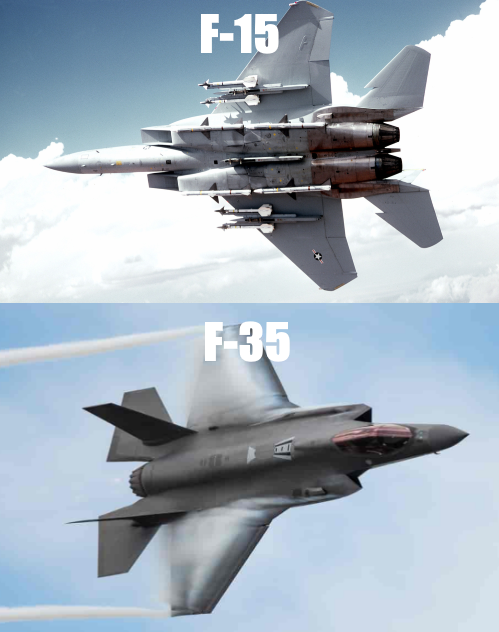
It’s worth mentioning that the United States Air Force does not consider the F-15 and F-35 rivals.
Rather, the Air Force prefers the F-15 for air superiority because of features like its larger weapons payload (more details, below).
Meanwhile, the USAF treats the F-35 as its premiere option for defending military installations as well as operations that require stealth.
As one former Air Force commander put it, comparing the two is like comparing apples to oranges.
Be that as it may, it’s always fun to spark up a fun debate between 2 of the most heralded military aircraft of all time.
Thus, in the discussion of F-15 vs. F-35, you also need to consider the dynamic of air superiority.
Air superiority, in other words, is the process of seizing control of the skies by defeating enemy fighters at their own approach.
For this reason, the F-15 and F-35 frequently clash regarding which fighter is better at air superiority.
There is little question that the F-15 Eagle is maneuverable for its size and incredible power.
Still, it lacks the same agility and maneuverability as the F-35 Lightning II.
There are few aircraft in the world that are harder to detect considering the tiny radar profile of the F-35.
Accordingly, the F-15EX factors to struggle against 5th-generation fighters and more advanced missile defense systems.
Regardless, the F-15 remains outstanding at short range.
The F-15 has over 100 confirmed kills with most of them taking place in air-to-air combat.
It competes with reports out of the Air Force that the F-35 features a 20:1 kill ratio compared to non-stealth aircraft.
Ultimately, both the F-15 and F-35 rank behind the F-22 Raptor as perhaps the most versatile of all modern fighters.
Related Article – F-16 Vs. F-18: Top 10 Differences Between The Viper & Super Hornet
#5. Armaments
How about weapons?
In the F-15 vs. F-35 discussion, you have to also consider the armaments of each fighter.
For the most part, the F-15 is superior to the F-35 in terms of weapons and ability to defend itself.
The F-15 Eagle supports more weapons load capacity with nearly 20 different options for armament.
It’s more versatile when you compare that to the payload capacity of the Lightning II (which only has room for 6).
The F-15 fighter intercepts bombers as well as launches back defense missiles.
Accordingly, the F-15EX variant supports 22 onboard air-to-air missiles compared to the “beast mode” configuration of the F-35 (upgrades to 16 air-to-air missiles).
However, unlike the F-15EX, the F-35 has the ability to transition into a “first day of war” internal armament configuration.
As a result, the aircraft loses some of its payload capacity yet exchanges it for maximized stealth.
Therefore, the fighter can exist in enemy or contest airspace longer since its skilled at evading anti-aircraft systems.
Lastly, the F-35 provides another tactical advantage considering its sensor fusion technology.
The technology vastly improves battlefield and situational awareness unlike anything the F-15EX can deliver.
Still, in terms of armament, it’s hard to not pick the F-15 which is designed to unleash a heavier ground-attack and aerial assault.
The F-35 does do a better job, however, at locating targets and staying away from danger.
#6. Stealth
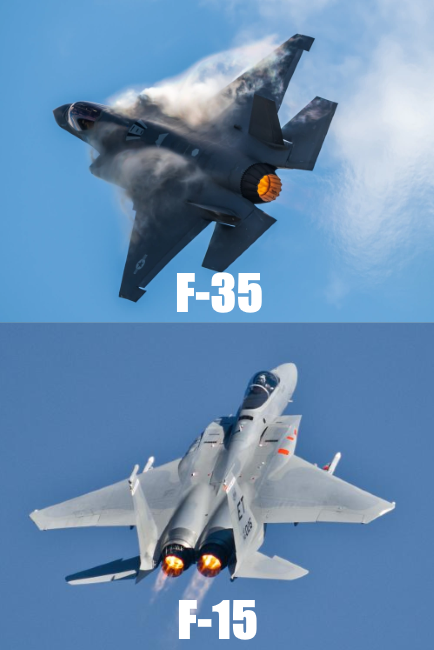
It brings us to the next point in the F-15 vs. F-35 discussion – stealth.
Stealth is critical in the skies especially against the elite aircraft and anti-aircraft weapons of enemy forces.
Therefore, the Department of Defense is once again pumping funds into developing highly sophisticated 5th generation fighters.
The F-15EX is impressive in many regards for a modern fighter yet lacks the same stealth capabilities of the F-35.
As previously noted, it’s not even close in terms of an infrared and radar profile the F-15 presents compared to the F-35.
Even the F-15EX is based on a half-century old airframe that lacks the modern advances of more stealthy aircraft.
Unfortunately, it doesn’t really matter how fast or what weapons if the aircraft is easy to detect.
Accordingly, the F-15 is not considered a “Day One” fighter like other aircraft (such as the F-35 Lightning II).
Rather, the F-15 is engineered to arrive enemy air defenses are degraded or destroyed.
On the other hand, the F-35 is precisely the type of aircraft you want on the front lines.
The aircraft delivers a minimal radar cross-section (approximately the size of a golf ball) and radar-absorbent materials (RAM).
It has the rare ability to penetrate enemy airspace as well as survive in contested areas.
There is an added advantage of existing in the skies without being detectable.
Furthermore, the F-35 is not easy to track down or catch once it’s discovered.
As a result, there are few aircraft on the planet that rival the F-35 in terms of stealth.
#7. Avionics
There is also plenty to rave about the avionics of the F-35 fighter.
The Lightning II aircraft features some of the most advanced and complex missions systems.
The sensor fusion is extremely resourceful and designed to improve situational awareness of the pilot.
There is a gigantic advantage of being able to examine a comprehensive image of the battlefield.
Plus, the avionics only contribute to what makes the F-35 so difficult to find in the skies.
The F-35 also transitions into an electronic warfare system that may detect or jam enemy radars.
Meanwhile, the original concepts of the F-15 aircraft are more dated and therefore do not feature the same technological advances.
However, that is slowly changing thanks to the evolution of the F-15EX.
The modern fighter offers far more advanced avionics designed to compete with the precedent set by the F-35 Lightning II.
The F-15EX presents several major changes since the last time the Air Force purchased the type of aircraft in 2001.
For starters, the new fighter features fly-by-wire flight controls, new electronic warfare suite, and advanced ADCP II avionics.
The software is compatible with other versions of the F-15 aircraft.
Secondly, the Eagle Passive Active Warning Survivability System (EPAWSS) overcomes some of the other stealth flaws of aircraft.
The F-15 is versatile enough to discover high-flying and low-flying targets while not confusing with ground clutter.
For this reason, the built-in radars may detect and track enemy aircraft at distances beyond visual range.
Finally, the cockpit display has been fully overhauled and looks similar to the T-X trainer.
#8. Reputation
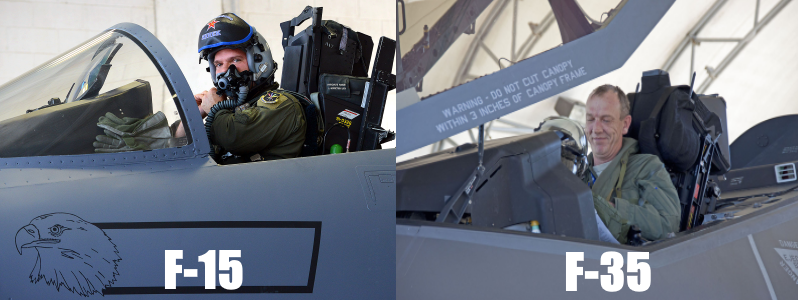
The United States dominates aviation which explains why its engineered the best modern fighters.
There is no debate that the F-15 is competitive in the skies with over 100 victories and 0 defeats in combat.
The F-15 Eagle has been utilized by several other countries, including the Israeli Air Force.
Despite it, the air superiority fighter may be inferior to the F-35 aircraft.
The Lockheed Martin F-35 Lightning II debuted in the early-2000s and has garnered a new precedent.
The F-35 fighter is among the most stealthiest (along with one of the best fighters in the world).
It has earned a reputation that only rivals the F-22 Raptor in terms of legacy.
The advanced stealth and sleek agility of the F-35 make it extremely difficult to take down in the skies.
The F-35 is currently used by the Air Force, Navy, and Marine Corps as well as the cornerstone of NATO and allied forces.
In fact, more than 10 partner nations have invested in F-35C aircraft.
Still, it’s hard to argue against the dog-fighting challenges the McDonnell Douglas F-15 possess.
It leads many to wonder how the Lightning II would perform against the F-35 Eagle in aerial combat, something the government tested in 2016.
The 2016 exercise discovered that the F-15 held no match against the F-35 (which had a kill rate of 8-0).
Be that as it may, the simulated environment does not necessary demonstrate that the F-35 is better than the F-15, according to one former pilot.
In reality, it’s plausible for the F-15 Eagle and F-35 Lightning II to exist together in the future.
The 2 fighters compliment each other in many regards and create a lethal fighting force paired together.
Unfortunately, the budget required to maintain both fighters may require the Department of Defense to make a choice.
And, if recent trends are evidence, the U.S. military may lean toward the new F-15EX in the future (despite costing more to produce compared to the F-35).
However, until that era arrives, the F-35 remains dominant and quite possibility the top stealth fighter in the world.
Related Article – Navy Pilot Vs. Air Force Pilot: 5 Main Differences Between Each
F-15 vs. F-35: The Verdict
By all accounts, the F-15 is highly capable and extremely advanced aircraft.
However, when you compare the fighter to the F-35 Lightning II, it’s impossible to dismiss the tremendous avionics and stealth capabilities.
The F-35 is harder to detect and competes with other 5th generation fighters.
Meanwhile, there are valid concerns about the lack of stealth in the F-15EX for a modern fighter.
Regardless, it’s weapons capabilities and sheer power rivals any competitor.
Therefore, the F-15 Eagle may put up a challenge in a dog-fight, but the F-35 remains superior in agility and maneuverability.
Furthermore, the enhanced sensor fusion keeps F-35 pilots one step ahead of opposing aircraft.
Sure, the F-15 remains undefeated in combat but it’s struggling to keep up with recent advanced in anti-aircraft weapons systems.
As a result, the F-15 remains a 4th generation aircraft at heart while the F-35 ranks among the world’s most advanced, 5th generation multi-role fighters.
It’s fully capable of fighting the battles of tomorrow.
- Ikon Pass Military Discount: Learn How To Save Big - January 31, 2025
- RTIC Military Discount: Find Out How To Save Big on Gear - January 30, 2025
- Traeger Military Discount: Learn How To Save Big on Smokers - January 28, 2025

